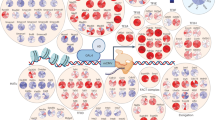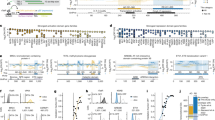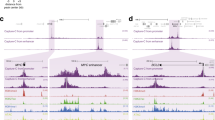Abstract
THE products of the fos and jun protooncogenes form a stable heterodimer which binds to the TPA-responsive element (TRE) TGACTCA with high affinity1-9. These two proteins, together with the yeast GCN4 protein, belong to a growing family of transcription factors, including FosB, Fral, JunB and JunD, whose members share a highly conserved DNA-binding domain10-14. This domain is composed of two structures: a basic motif, which is thought to bind directly to DNA; and a leucine zipper15, which provides a dimerization interface. Although this domain is highly conserved in Fos, Jun and GCN4, each of these three proteins has very different relative affinities for the TRE. To understand these differences, we used 'domain-swapping' experiments designed to test the relative contributions of the basic motif and the leucine zipper to TRE-binding affinity. Here we show that fos, jun and GCN4 have different affinities for the TRE due to differences in the hetero- or homo-dimerization capacity of their leucine zipper domains; the basic motifs of these three proteins have comparable DNA binding potential. These results indicate that leucine zippers control the types of protein complexes which can associate with a TRE and regulate gene expression.
This is a preview of subscription content, access via your institution
Access options
Subscribe to this journal
Receive 51 print issues and online access
$199.00 per year
only $3.90 per issue
Buy this article
- Purchase on SpringerLink
- Instant access to full article PDF
Prices may be subject to local taxes which are calculated during checkout
Similar content being viewed by others
References
Kouzarides, T. & Ziff, E. Nature 336, 646–651 (1988).
Sassone-Corsi, P., Ransone, L., Lamph, W. W. & Verma, I. M. Nature 336, 692–695 (1988).
Nakabeppu, Y., Ryder, K. & Nathans, D. Cell 55, 907–915 (1988).
Halazonetis, T. D., Georgopoulos, K., Greenberg, M. E. & Leder, P. Cell 55, 917–924 (1988).
Rauscher, F. J. III, Voulalas, P. J., Franza Jr, B. R. & Curran, T. Genes Dev. 2, 1687–1699 (1988).
Schuermann, M. et al. Cell 56, 507–516 (1989).
Turner, R. & Tjian, R. Science 243, 1689–1694 (1989).
Gentz, R., Rauscher, F. J. III, Abate, C. & Curran, T. Science 243, 1695–1699 (1989).
Neuberg, M., Schuermann, M., Hunter, J. B. & Muller, R. Nature 338, 589–590 (1989).
Zerial, M. et al EMBO J. 8, 805–813 (1989).
Cohen, D. R. & Curran, T. Molec. cell. Biol. 8, 2063–2069 (1988).
Ryder, K., Lau, L. F. & Nathans, D. Proc. natn. Acad. Sci. U.S.A. 85, 1487–1491 (1988).
Ryder, K., Lanahan, A., Perez-Albuerne, E. & Nathans, D. Proc. natn. Acad. Sci. U.S.A. 86, 1500–1503 (1989).
Vogt, P. K., Bos, T. J. & Doolittle, R. F. Proc. natn. Acad. Sci. U.S.A. 84, 3316–3319 (1987).
Landschulz, W. H., Johnson, P. F. & McKnight, S. L. Science 240, 1759–1764 (1988).
Hope, I. A. & Struhl, K. Cell. 46, 885–894 (1986).
Hope, I. A. & Struhl, K. EMBO J. 6, 2781–2784 (1987).
O'Shea, E. K., Rutkowski, R. & Kim, P. S. Science 243, 538–542 (1989).
Kunkel, T. A. Proc. natn. Acad. Sci. U.S.A. 82, 488–492 (1985).
Vosatka, R. J., Hermanowski-Vosatka, A., Metz, R. & Ziff, E. B. J. Cell Physiol. 138, 493–502 (1989).
Distel, R. J., Ro, H-S., Rosen, B. S., Groves, D. L. & Spiegelman, B. M. Cell 49, 835–844 (1987).
Curran, T., Gordon, M. B., Rubino, K. L. & Sambucetti, L. C. Oncogene 2, 80–84 (1987).
Melton, D. A., Krieg, P. A., Rebagliatti, M. R., Maniatis, T., Zinn, K. & Green, R. Nucleic Acids Res. 18, 7035–7056 (1984).
Author information
Authors and Affiliations
Rights and permissions
About this article
Cite this article
Kouzarides, T., Ziff, E. Leucine zippers of fos, jun and GCN4 dictate dimerization specificity and thereby control DNA binding. Nature 340, 568–571 (1989). https://doi.org/10.1038/340568a0
Received:
Accepted:
Issue Date:
DOI: https://doi.org/10.1038/340568a0



